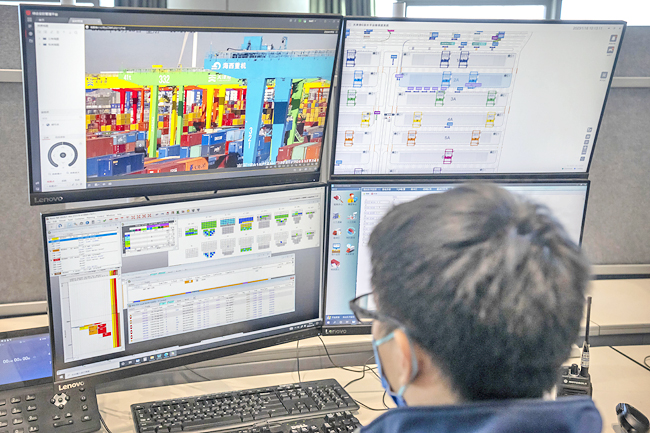TIANJIN, CHINA (AP) – As technicians in a distant control room watch on display screens, an automated crane at one of China’s busiest ports moves cargo containers from a Korean freighter to self-driving trucks in a scene tech giant Huawei sees as its future after American sanctions crushed its smartphone brand.
The backbone of the “smart terminal” at the Tianjin Port, east of Beijing, is a data network built by Huawei, which is reinventing itself as a supplier for self-driving cars, factories and other industries it hopes will be less vulnerable to Washington’s worsening feud with Beijing over technology and security.
The ruling Communist Party is promoting automation in industries from manufacturing to taxis to keep China’s economy growing as the workforce ages and starts to shrink.
Its managers said the “smart terminal”, part of Tianjin’s 200-square-kilometre port, allows 200 employees to move as much cargo as 800 used to.
“We believe this solution in Tianjin is the world’s most advanced,” said the chief technology officer of Huawei’s business unit for ports Yue Kun. “We believe it can be applied to other ports.” Huawei Technologies Ltd, which makes smartphones and is the biggest global supplier of network gear for phone carriers, struggled after then-president Donald Trump cut off access to American processor chips and other technology in 2019 in a feud with Beijing about security.

Huawei, with a workforce of almost 200,000, has held onto its status as the leading maker of network gear based on sales in China and other markets where Washington has had less success at encouraging governments to shun the company. “Huawei is already a key player” in data networks with a “wealth of knowledge”, said an industry analyst Paul Budde.
The company has created 20 teams to focus on factories, mines, hospitals, ports, power plants and other industrial customers.
It said the auto unit has 3,000 people working on autonomous driving and invested USD2 billion in the technology in 2020-21. Huawei was an early developer of “smart city” networks for traffic control and police surveillance.
“The big, black cloud here, however, is geopolitics,” said Budde. “This will hamper its participation in overseas markets,” he said. “The issues are not technology but are purely political.”
Huawei said its new focus already is helping to revive the company’s fortunes.
“In 2020, we successfully pulled ourselves out of crisis mode,” said one of three Huawei executives who take turns as chairman Eric Xu, in a December letter to employees. “US restrictions are now our new normal, and we’re back to business as usual.”
Last year’s revenue was forecast to be little changed from 2021 at CNY636.9 billion, Xu said. That was below Huawei’s double-digit growth of a decade earlier but an improvement over the 5.9 per cent slide in the first half.
He gave no breakdown by business line, but Huawei reported 2021 sales to industrial customers of CNY102.4 billion. Sales of smartphones and other devices fell 25.3 per cent from a year earlier in the first half of 2022 to CNY101.3 billion.
The auto unit, which supplies components and software for navigation, dashboard displays and managing vehicle systems, has played a role in five models released by three Chinese automakers.
The ruling party’s urgency about rolling out automation has risen as the size of China’s working-age population 16 to 59 declined after hitting a peak in 2011.
That group has shrunk by about five per cent. Its share of the population slid from 70 per cent to 62 per cent.
The Tianjin port managers told Huawei they already were having trouble finding and keeping truck drivers, according to Yue.
“This can help to address the ageing population issue,” said Yue.
Yue said Huawei has talked with “people outside China” who might use its port technology, but he gave no details.
The annual market for port-related network technology is modest at USD2 billion, but global sales of gear to link factories and medical equipment, cars and other devices total USD600 billion a year, according to Budde. He said that has the potential to replace Huawei’s lost smartphone and other telecom sales, so long as foreign buyers aren’t put off by security concerns.
The Tianjin port’s fleet of 88 battery-powered autonomous trucks is charged by wind turbines, according to a port spokesman, Peng Pai.
“It’s much safer, and it uses clean energy,” said Peng.
In a third-floor control room with floor-to-ceiling windows that look out over the port, a dozen operators sit in front of displays with as many as six screens showing video feeds of computer-controlled cranes lifting cargo boxes onto or off ships.
Each can monitor as many as six cranes at once, unlike a traditional operator who serves only one ship.
“People had to work high up in cranes,” said Yang Jiemin, a vice president of Tianjin Port Group. “Now, our operators can sit in an office and monitor equipment remotely.”






